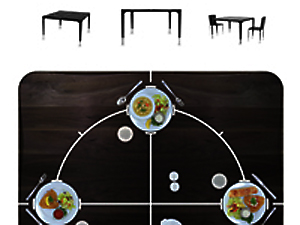
Life-enriching Design Exhibition
At the University of Alberta, that supposing translates into tangible outcomes researchers say will change our relationship with our environment while helping us live longer, happier, independent lives. But to get there, design changes to just about everything-from buildings to pill dispensers-need to happen.
"Most designs today don't take into account ideas of equitable use, quality of use, access, simplicity in use or reduction of error. That is where we are coming from," said Robert Lederer, industrial art and design professor at the U of A. And the direction, Lederer says, should head toward an approach called universal design, which is commonly defined as broad-spectrum ideas meant to produce buildings, products and environments that are inherently accessible to both people with and without disabilities.
"We who practice universal design consider the psychological well-being of the user. So in a user-centred designed space, for example-which is part of universal design theory-people are happier and perform better. Universal design is about providing the best possible facility, whether it's a space, a device or system, which can allow someone to be the best they are. It is about the sensitivity of needs," said Lederer.
Starting today, Lederer and his colleagues will exhibit samples of their designs that they say goes beyond the theoretical applications of universal design to highlight solutions to real, everyday problems.
The exhibition, More than just Universal Design, features the work of various faculties and departments including computing science, occupational therapy and the Faculty of Extension. Features include the Moon Table, which provides a user-centred dining experience for people with vision loss; A dialysis chair that changes how a patient receives blood transfusion-from laying down to sitting upright-makes it possible for patients to read, draw or play board games while receiving treatment. A watch that doubles as a glucose monitor for diabetics will also be on display.
Lederer says universal design is also a less expensive approach to dealing with issues arising from an increasingly older population.
"Governments can't afford to build more assistive care centres," he said. "It is much cheaper and cost-effective to keep people in their homes as long as possible. And to make that possible we have to change a lot of elements within their environments and provide them with systems that will allow them to safely stay in their homes."
Lederer says a smart condo is one example of such a system. The smart condo is a prototype living space designed at the U of A that enables elderly people with medical conditions to live independently. Its design allows for monitoring systems that relay information on the health status of its occupant to health-care professionals, who could quickly respond when needed. Lederer say that, by understanding and monitoring the health status of an occupant in the condo, a noticeable change in their condition would provide professionals time to deal with the problems before they become emergencies.
"What usually happens is that, once someone ends up in the emergency room once or twice, the response has been, 'off you go to the nursing home.'" Lederer said. "A lot of times when patients are taken to these facilities, they deteriorate faster due to depression; this is especially so for people in the early stage of Alzheimer's disease who are taken out of their known environment."
The exhibition opens April 28 at the atrium of Enterprise Square with a reception starting at 6 p.m. The show runs until May 18.